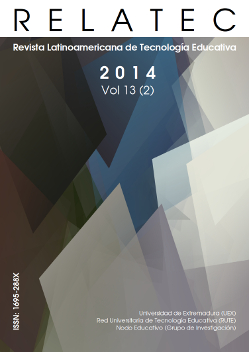Diseño de un entorno 3D para el desarrollo de la competencia digital docente en estudiantes universitarios: usabilidad, adecuación y percepción de utilidad / Design of 3D environment to develop pre-service teachers' digital competence
DOI:
https://doi.org/10.17398/1695-288X.13.2.35Keywords:
formación inicial docente, competencia digital, entornos virtuales, aprendizaje virtual, tecnología educativaAbstract
Una de las condiciones esenciales para el desarrollo de la competencia digital docente de los futuros docentes es proporcionarles situaciones de aprendizaje que permitan ejercitar tales habilidades, conocimientos y actitudes en contextos similares a su futura realidad profesional. Los entornos virtuales 3D, altamente inmersivos e interactivos, son una tecnología prometedora para simular escenarios reales y ofrecer dichas oportunidades de aprendizaje. El objetivo de esta investigación es presentar el diseño de un entorno 3D para el desarrollo de la competencia digital docente, centrado en el análisis de: (1) la usabilidad tecnológica y gráfica; (2) la adecuación del contenido de las actividades; y (3) la practicidad y utilidad pedagógica del entorno. Para ello, siguiendo la metodología de investigación para el diseño, se llevó a cabo un proceso de validación con distintos grupos de informantes clave: expertos en tecnología, docentes relacionados con la tecnología educativa y estudiantes de los grados de educación, a los que, además, se les administró un cuestionario de percepción de la utilidad pedagógica (Code et al. 2013). Los resultados muestran que a nivel tecnológico el entorno funcionó de manera fluida, aunque los gráficos resultaron limitados. A nivel didáctico, las actividades propuestas fueron adecuadas, realistas y actuales, y, a pesar de la complejidad inicial en el control de los avatares, destaca la alta motivación de los estudiantes debido a la similitud del entorno con su futura práctica profesional. La principal conclusión es que los entornos 3D son escenarios viables para el desarrollo actividades didácticas que favorezcan la adquisición de la competencia digital docente.
Abstract
One of the most important conditions for the development of pre-service teachers' digital competence is to provide them with learning experiences to put in action such skills, knowledge and attitudes in similar contexts to their future professional reality. 3D virtual environments are an immersive and interactive promising technology that allow to simulate real scenarios and provide these learning opportunities. The aim of this reserach is to show the design of a 3D environment for the development of teachers' digital competence, focusing to the analysis of: (1) technical and graphical usability; (2) content adequacy of the activities; and (3) practicity and pedagogical usability of the environment. For this purpose, following design-based research method, we conducted a validity process with different key informants groups: technology experts, teachers related to educational technology, and students-teachers who also answered a pedagogical usability questionnaire (Code et al., 2013). From a technological view, the results show that the environment worked fluently, but the graphics were limited. From a educational point of view, the activities were appropriate, realistic and current. the activities were appropriate, realistic and current. Despite the initial complexity in the avatars control, they emphasized its high motivation due to the similarity of 3D environment with their future professional work. The main conclusion of this work was that 3D environments are useful technology for developing educational activities that promote the acquisition of teachers' digital competence.
Downloads
Downloads
Published
Issue
Section
License
Authors who publish in this journal accept the following conditions:
1. The Author retains copyright in the article. Upon acceptance of the article, the author shall grant to the Publisher the right of first publication of the article. with the dcoument registered with the Creative Commons Attribution-NonCommercial-NoDerivative 4.0 International (CC BY-NC-ND) license, which allows to third parties to use what is published whenever they mention the authorship of the work and the first publication in this journal.
2. Authors can make other independent and additional contractual agreements for the non-exclusive distribution of the article published in this journal (eg, include it in an institutional repository or publish it in a book) provided they clearly indicate that the work was published for the first time in this journal.
3. Authors are allowed and recommended to publish their work on the Internet (for example on institutional or personal pages) before and during the review and publication process, as it can lead to productive exchanges and a greater and faster diffusion of published work (see The Effect of Open Access).









